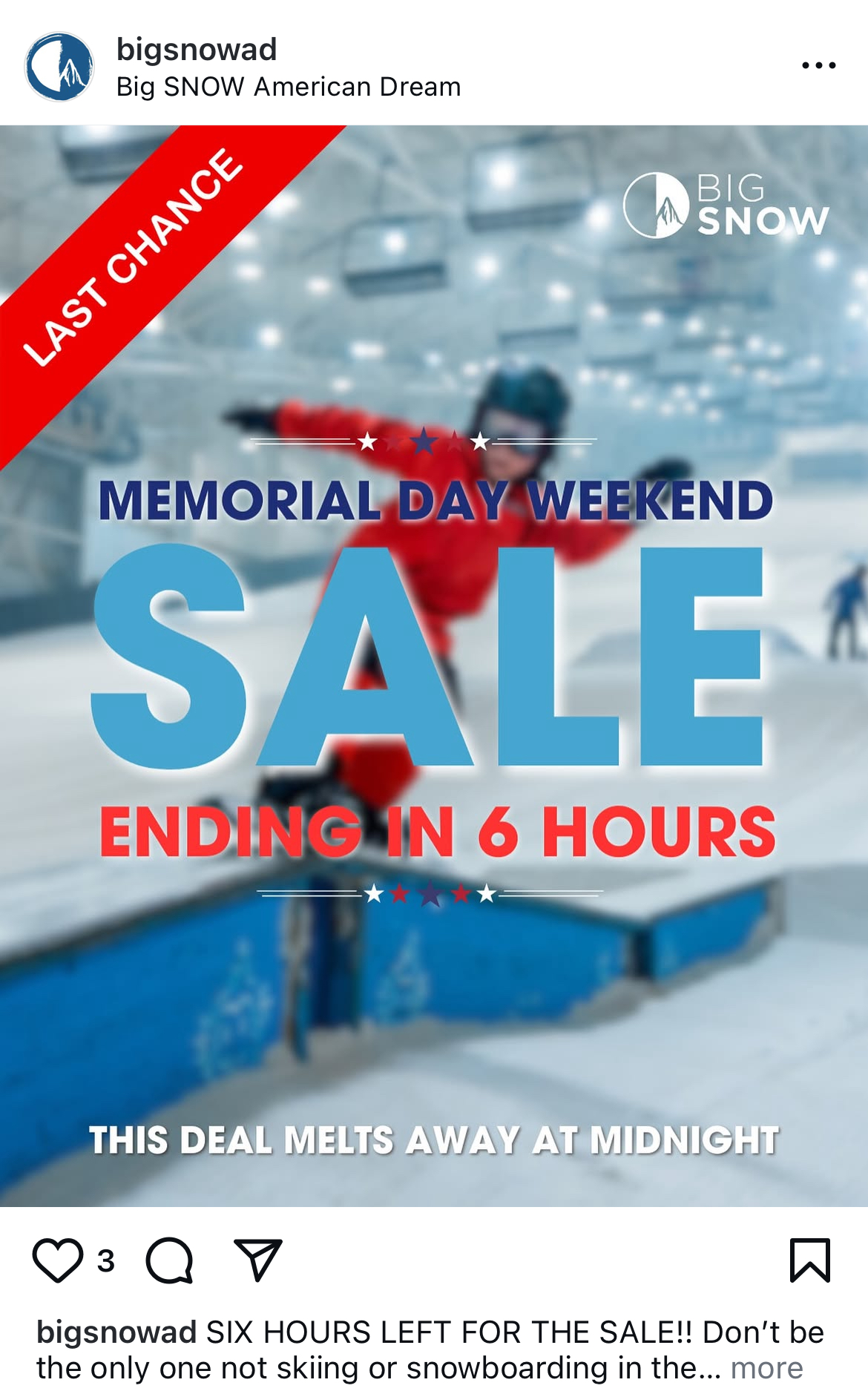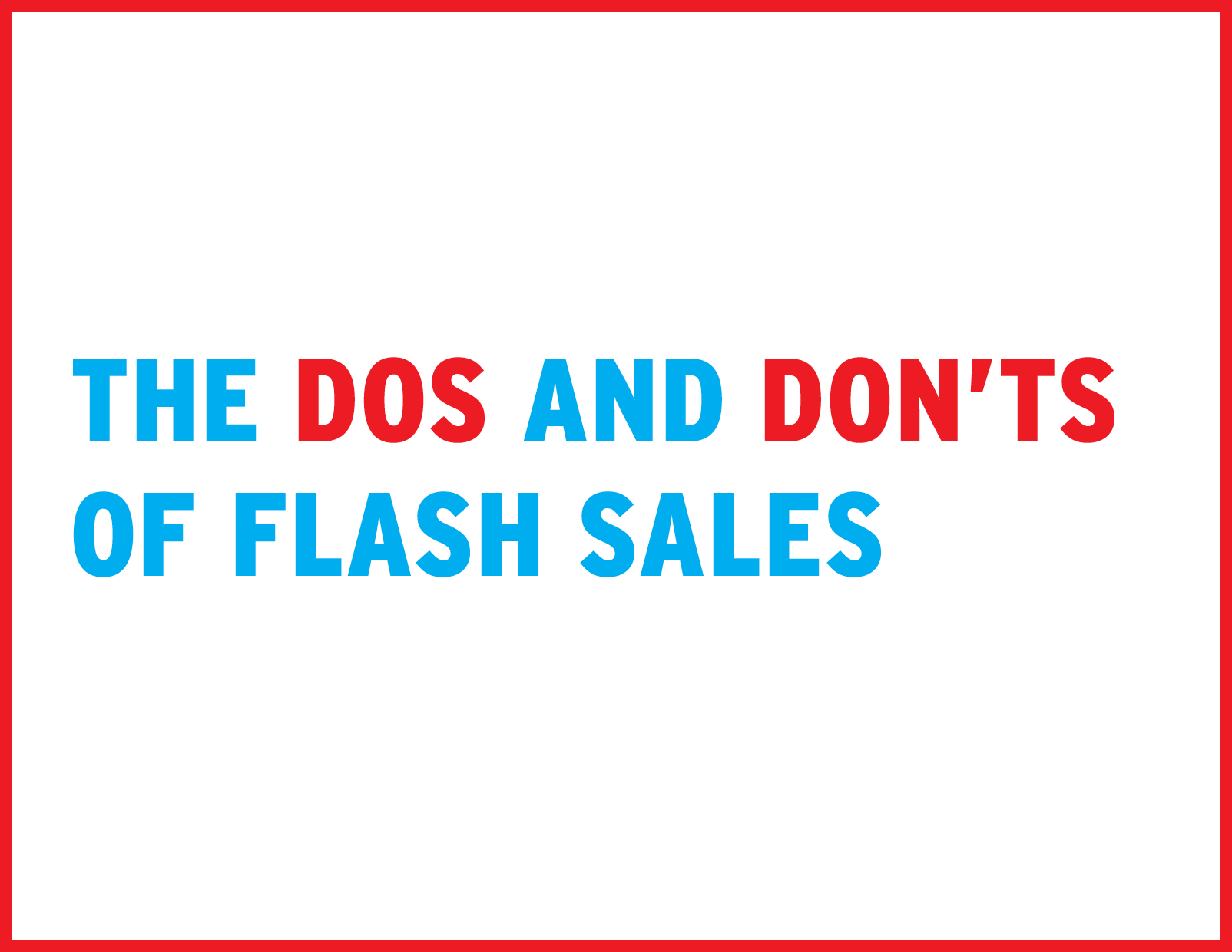There are a couple of universal truths we know about most skiers and snowboarders: 1) They love a deal, and 2) They get FOMO very easily. Savvy sales and marketing teams can capitalize on this combination by occasionally pulling one tried and true trick from their bag of tactics: the flash sale.
Behind the scenes, these short-lived opportunities give us a chance to get creative with everything from pricing and messaging to strategy and content. They can be wildly spontaneous, like low-risk gambling from the convenience of your office chair. Or, they can be highly planned, with months of preparation for a coveted offering. Flash sales can appeal to a variety of customer types—from those who mark their calendar for season-pass price breaks to those who can be persuaded by a good deal to book a last-minute room with 48 hours’ notice.
Flash sales are a good thing to have in your overall marketing mix. “You have to do your audience some favors, you can’t just hard sell all the time,” says Inntopia vice president of marketing Gregg Blanchard. Offer some great deals with the occasional flash sale, and “be useful, be entertaining, be interesting,” he says, to keep people’s attention.
While successful flash sales can maximize ticket sales on a slow day or fill beds during a need period, they should be deployed judiciously, lest you train customers to hold out for those deals. “Flash sales are a tactical tool,” says Boyne Resorts chief marketing officer Nick Lambert. “They’re just one part of a larger sales strategy.”
Flash Sale Do’s & Don’ts
 Countdowns, like this one for a Big Snow summer sale, help create a feeding-frenzy effect.DO: Create Urgency & Scarcity
Countdowns, like this one for a Big Snow summer sale, help create a feeding-frenzy effect.DO: Create Urgency & Scarcity
If there’s one big takeaway, it’s that FOMO is your best friend. “A good flash sale should be short enough that folks will ‘act now’ instead of waiting, but long enough that it gives everyone a fair chance,” says Blanchard. The aim is to find the right combination of buttons to press to create that can’t-miss, short-lived opportunity that folks will lose sleep over.
“We’ve found that scarcity drives urgency, so we run flash sales in two primary formats,” limited-quantity and limited-time, says Snow Partners chief marketing officer Hugh Reynolds.
“Limited quantity sales mean we release a set number of products at a discounted rate, and sell until they’re gone. This works extremely well for high-demand items like season passes and multi-visit cards, especially when launching new or seasonal offerings. To maximize impact, we promote the release in advance with countdowns via email and social media, building anticipation to create a ‘feeding frenzy’ effect.”
For limited-time sales, often for products with lower organic demand, Snow Partners keeps the windows tight (48-72 hours). It supports the offers with countdowns and messaging to create urgency. “By limiting the time, we can better control when purchases and revenue occur, which is helpful for specific financial targets or pacing needs,” says Reynolds.
DON’T: Condition Your Customers
Too much of a good thing will train your customers to wait for the deal or, perhaps worse, ignore your communications entirely. “If you have a flash sale every week, it loses its effectiveness, and people start to tune it out,” notes Lambert.
Of course, Boyne aims to train its customers, just in the right ways. “We urge them to buy their season pass in the spring to get the best rate, or book their lift tickets days or weeks in advance for a better deal,” says Lambert. “It works, but when adding too many offerings, it can become confusing at best, and detrimental at worst.”
DO: Experiment with Sale Products
Since every resort has different products and offerings, experiment to learn which products are best suited to flash sales. Don’t be afraid to throw things at the wall to see what sticks.
“Flash sales can be as complicated as you want them to be, but I’d err on the side of simplicity if you haven’t done them very often,” advises Blanchard. “Choose one product that needs a boost, create one promo code that only applies to that product, set it to expire in a couple of days, whip up a quick email template and social graphic, and hit send. As you learn and measure the ROI on these, you can see if it’s worth putting more time and effort into them.”
A great place to start is pre-commitment product categories, as Lambert calls them, which can include ski access and lodging.
“Products with strong baseline demand perform best,” adds Reynolds. “We tend to avoid using flash sales for low-margin or lower-demand items where urgency is harder to create.” Of course, you know your guests best, so use that knowledge to help determine what products would be most attractive.
DON’T: Skimp on the Deal
A good flash sale should stop customers in their tracks. Make sure that your offering is enough to halt a person from scrolling, deleting the email, or disregarding a text from an unknown number.
“In my experience, the greater you are willing to discount, generally, the more you can move the needle,” says Reynolds.
For Snow Partners’ Big SNOW and Mountain Creek, both in New Jersey, it comes down to how much yield they are willing to trade to drive gross revenue when they need it most. “Our findings were that 20 percent wasn’t enough motivation to move volume, 30 percent did better, and 50 percent did best,” says Reynolds. “Test different options to find where the tipping point is for your audience.”
Boyne Resorts has experimented with “psychologically attractive price points like $99, $149, $199, et cetera,” Lambert says. Rarely do they have a promotional sale fall flat, but they can fall short of expectations. When a sale doesn’t perform as expected, Lambert and his team will ask themselves: Was the price too high? Was the sale window too short? Did the deadline fall on a bad day? Was the sale period too early or too far in advance?
Sometimes, it might come down to perceived value. “We’ve found a few interesting nuances through testing,” says Lambert. “In a few cases, an offer of X dollars off works better than a percentage off, even though the percent savings was greater than the dollar savings!”
DO: Spread the Word Far and Wide
With so many ways to connect nowadays, find a recipe that feels right for your brand and your customer base. Maybe it’s an entirely SMS campaign, maybe it’s organic social, or maybe it’s a heavily focused email campaign with the help of your CRM.
“I tend to stick with channels like email and SMS where I know that within 24 hours of hitting send, the vast majority of people on that list will have seen my message,” explains Blanchard. “If it’s a really niche product, those channels also allow me to segment down to make sure I’m only paying to show that to folks who are very relevant to the offer. Social doesn’t have the segmentation, but it does have a short shelf life and low cost. So pairing email/SMS with social would probably be where I’d focus.”
“We use all available channels: website, email marketing, onsite (‘four-wall’) marketing, organic social media, paid social campaigns, and occasionally, display advertising,” says Reynolds. “A coordinated, multichannel approach is key to maximizing visibility and conversion.”
Lambert suggests sending reminder emails at certain points during a limited-time sale (“Only 12 hours left to book!”), or inventory updates during a limited-quantity sale. For the latter, Boyne-owned Sunday River ran a preseason ticket sale a few years ago with limited inventory of the best prices and sent emails over a three-day span with subject lines: “50% Gone: Tickets from $49;” “85% Gone: Tickets from $49;” and “Last Call: Tickets from $49.”
If it feels authentic to the way you normally communicate with your guests, it’s worth exploring.
DON’T: Forget to Test Your Tech
Don’t let your technology fail you in your moment of need. Make sure your website, your sales system, and especially your staff overseeing it all are prepped and ready to go.
“Resorts typically use their existing e-commerce platforms unless the promotion is being run through a third party,” says Lambert. “The key consideration is ensuring that your platform is capable of handling increased traffic and transaction volumes during high-demand windows.”
Snow Partners’ cloud-based sales system auto-scales based on demand, allowing it to handle spikes in traffic and transaction volumes without performance issues, says Reynolds, adding, “Any platform that can’t scale or handle high-volume sales would be a serious limitation. Today’s consumers expect a seamless experience and have very little patience for slow or broken checkout processes.”
Flash Back
The various incarnations of flash sales can be a game-changer, as long as you don’t overdo it and accidentally condition your guests to become deal-crazed addicts.
Your north star should be the deep understanding you have of your guests. The rest of the recipe includes a dollop of urgency, a pinch of strategy, and just enough chaos to make things interesting. The right mix can drive big results and even bigger guest engagement. So, test your tech, pick your products wisely, and hype up each sale like it’s the can’t-miss offer of the year. Do it well, and your guests won’t just spend their hard-earned dollars with you—they’ll happily set alarms to do so.






